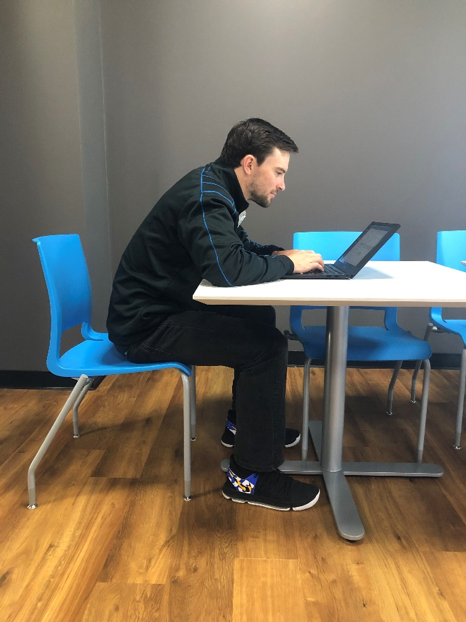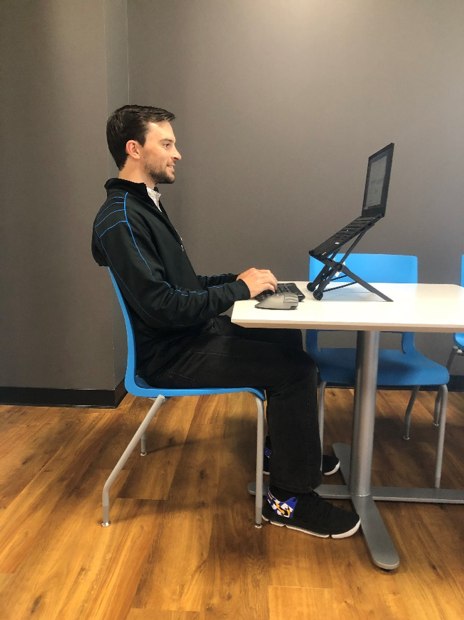No matter where you perform work tasks – at home, on campus, or on the go, it is important to set-up your work area with ergonomics in mind. The cumulative effect of working without a proper workstation setup, especially when combined with laptop, smartphone, or tablet use, may increase the likelihood of discomfort or injuries. Use the guidance and resources below to set up your workstation like a pro!
When working at home in a hybrid or remote work arrangement, EH&S Ergonomics recommends the use of an adjustable chair, external keyboard and mouse, and an external monitor or laptop riser to raise the laptop screen to eye height.
Working directly on a laptop without the use of external peripherals whether on a table or in your lap is not advisable for long periods of time as it places the body in a compromised posture. Aim to keep laptop use to under 2 hours per day when used without external peripherals.
Simple adjustments and tools can make a big difference in your posture and how you feel at the end of the day.
Before Adjustments
 After Adjustments
After Adjustments
 Chair
Chair- Adjust your seat height with your hips slightly higher than your knees and your feet fully supported on the floor or a footrest.
- Note: You may need to adjust your seat height based on the height of your worksurface. Your elbows should be at the same height as the worksurface with your shoulders relaxed and your forearms parallel to the floor. For many individuals, this is appropriately at navel height.
- Sit deep in your seat with your spine fully supported by the chair.
- Ensure your low back is supported
- Adjust armrests to support your forearms when needed. Avoid positioning the armrests above your elbow height and placing body weight on the armrests
- DIY Hacks:
- Try using a small box, crate, book, or kitchen stepstool for a footrest.
- Explore the use of cushions and pillows to provide support when necessary.
- If needed, use a rolled-up towel for added spine support. The towel should run the length of the spine. Place it between the shoulder blades to encourage a more upright posture when seated.
- Adjust your seat height with your hips slightly higher than your knees and your feet fully supported on the floor or a footrest.
Worksurface- Choose a sturdy surface to set up your computer workstation.
- If possible, choose a surface that is <2” thick. Try to avoid surfaces that have a deep lip or apron
- The keyboard and mouse should be positioned at seated elbow height (approximately height of your navel with your shoulders relaxed and forearms parallel to the floor).
- Avoid reaching; bring your keyboard and mouse close to your body so your elbows rest by your sides; position your mouse directly next to the keyboard.
Monitor- Adjust the monitor height so the top of the screen is at eye-level. Lower the screen if wearing progressive/bifocal lenses. Adjust tilt angle so that the bottom of the screen is closer to you.
- If possible, connect your laptop to an external monitor. If you do not have an external monitor, raise your laptop to eye level using a riser, box, or books
- Place the monitor at a distance to avoid leaning forward or backward when viewing the screen
- Center your monitor with your keyboard and mouse
- Place laptop on a riser or stack of books to raise the screen height during video meetings.
- Hybrid Workers
Employees working in approved Hybrid work arrangements are eligible to purchase up to $250 for basic necessary ergonomic equipment for their telecommuting/home worksite after completing the steps listed below.
For more detail, review the Guidelines for Home Office Equipment for Hybrid workers and discuss any questions with your manager.
Steps Prior to Obtaining Home Office Equipment
- Complete Ergonomics Training – EHS-3400 Computer Workstation Ergonomics (in STARS), if not completed in the past two years.
- Complete this online training with your home workstation in mind to help ensure proper setup.
- Complete the computer workstation self-assessment tool
- Based on self-assessment results, determine if equipment is needed
- Select necessary items from the EH&S Pre-Approved Computer Ergonomics Product List
- Obtain approval from your manager prior to ordering equipment and follow your department’s ordering procedures
- Complete Ergonomics Training – EHS-3400 Computer Workstation Ergonomics (in STARS), if not completed in the past two years.
Remote WorkersEmployees on approved Remote work arrangements will be provided with a one-time taxable payment of $750 to purchase basic home office equipment to ensure a productive and safe home work environment.
For more detail, review the Guidelines for Home Office Equipment for Remote workers and discuss any questions with your manager.
Steps Prior to Obtaining Home Office Equipment
- Complete Ergonomics Training – EHS-3400 Computer Workstation Ergonomics (in STARS), if not completed in the past two years.
- Complete the computer workstation self-assessment tool
- Based on self-assessment results, determine if equipment is needed
- Refer to the EH&S Pre-Approved Computer Ergonomics Product List of approved computer workstation equipment and links to help you find suppliers
Home Office Equipment FAQ- Q: Will Stanford provide equipment for my home office?A: Refer to Obtaining Equipment for Home Offices sections above for Hybrid or Remote workers. Learn more at Guidelines for Home Office EquipmentQ: Can I order an item that is not included in the EH&S Pre-Approved Computer Ergonomics Product List?
A: The catalog items were selected based on availability, cost, and ergonomics. Equipment purchases outside of the catalog are at your department’s discretion. See Guidelines for Home Office Equipment for more details.
Remote workers are encouraged to refer to the EH&S Pre-Approved Computer Ergonomics Product List to guide equipment purchases.
Q: If I have already completed the ergonomics training, do I need to take it again?A: If you have taken the training within the last two years, it is not necessary to complete it again (check your training history in STARS to confirm your completion date). However, it may be beneficial to repeat the training if you are setting up a new workstation to provide you with setup guidance or you may use the computer workstation self-assessment tool to determine workstation setup needsQ: Can I use the EH&S Computer Workstation Ergonomics Equipment Reimbursement Fund for home office equipment purchases?A: Yes, all Stanford employees who have not yet participated in this program are eligible to apply for reimbursement of departmentally-purchased equipment used on campus and/or their home office. Learn more about the Computer Workstation Ergonomics
Equipment Reimbursement Fund. Note: the EH&S Ergo Equipment Reimbursement Fund is available until the funds are exhausted.
Q: I am a remote worker. May I use the EH&S ergonomics equipment reimbursement fund?A: The ergonomics equipment reimbursement fund does not reimburse individuals for personal purchases; however, if equipment is purchased by the department, it may be eligible if all other requirements to use the fund have been met.Q: Do I need to have an ergonomics evaluation with EH&S Ergonomics in order to purchase equipment for my home office?A: No, an ergonomics evaluation with an EH&S ergonomics specialist is not required in order to be eligible to purchase equipment for your home office.Q: I have a keyboard and mouse at the office. May I order a second set for use at home?A: Ordering a second keyboard and mouse for use at home is at the discretion of your department. If you are transporting your keyboard and mouse to and from the office, consider using a backpack (wear both straps and keep overall weight as light as possible) or a roller bag.Q: What should I do if I need help to select equipment for my home office?A: First, complete EHS-3400 training and the computer workstation self-assessment tool. If additional help is needed or to request an ergonomic evaluation with EH&S, please fill out the Request Ergonomic Services form.Additional Resources for Home Office Equipment
- The Stanford Surplus Store offers discounted furniture, free external monitors (for Stanford work) and additional equipment that can help reduce personal cost of providing an ergonomic workstation in your home office. EH&S also recommends consulting with your Local IT for potentially spare keyboards/mice that can be used when working from home.
- University IT also has standard equipment recommendations (for both Mac and PC) in their Work Anywhere Toolkit.
Do you travel for work or work during your commute on the bus or train? Ergonomics on-the-go can be tricky and it may be challenging to achieve neutral postures. As a result, it is important to take more frequent breaks, keep work duration short, and save more intensive work tasks until you have access to a fully-equipped workstation. Here are some other tips you can consider when working on-the-go:
- Use a rolled hand-towel or jacket to provide low back support
- Use a travel mouse to reduce awkward wrist and hand postures associated with laptop trackpad use
- Angle the laptop with the keyboard sloping slightly towards your body (12-15 degree slope) to reduce forward head posture. Use a laptop wedge, a binder, a small box, a book, or even a stack of napkins in a pinch!
- Use a backpack or folded jacket under the laptop to raise the screen height
- Use voice dictation whenever possible on your smartphone
- Staying in a hotel? Use an ironing board adjusted to your elbow height as your workstation
- Even if your workstation is the ideal setup, it is critical to take frequent breaks to move and stretch. Your next posture can be your best posture!
- Take a one to two-minute microbreak every 20 to 30 minutes to reduce sustained awkward postures and repetitive motions.
- Breaks are emphasized when using a laptop or other ergonomically-compromised work stations.
- Refer to the Stretching & Microbreaks pages for more information.
- Consider downloading StandUp, a free break reminder app.
